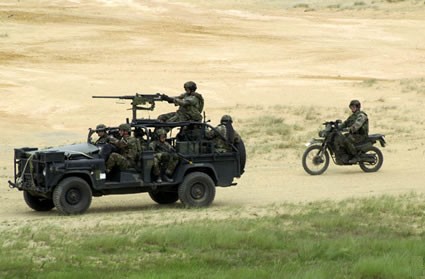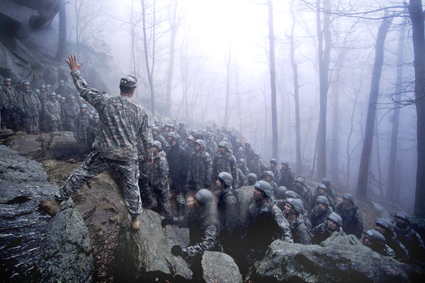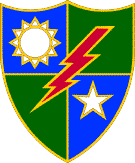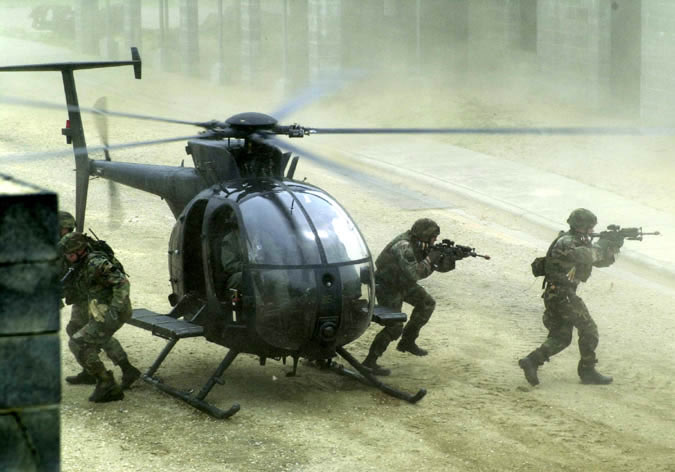Unit Profile
The US Army Rangers were originally raised as a Special Forces unit. Nowadays they are the US Army elite light infantry. The regiment is used as a Rapid Deployment Force.
The name Ranger had been used during earlier conflicts with the United States. The first famous Ranger unit was Rogers Rangers. Captain Robert Rogers organised a total of nine companies during French Indian War of 1754 - 1763. The unit was disbanded after the conflict. The next time the name Ranger was used again was during the War of King Philip with the Indians of 1670- 1675, during this period Captain Benjamin Church raised a company of Rangers in 1670.
Also during the American Revolution (1775 - 1983) and the Civil War of (1861 - 1865) companies of Rangers were raised. After the conflicts the units were again disbanded. All early Ranger units had one thing in common. They all participated in unconventional warfare. It would take until World War II before a new and more permanent version of the Rangers would emerge.
On the Western Frontier they were activated on June 19th 1942 during World War II after the British Commandos. A total of seven Ranger battalions were founded during the cause of the war. Ranger units 1 to 5 fought in Africa, Sicily, Italy and France. On the Pacific front Ranger unit 6 fought in New Guinea and the Philippines. During that same period of time in the pacific Merrill's Marauders fought in Burma. Although not designated as a Ranger Unit, the certainly fought like one in Burma. All were disbanded after the had ended.
During the Korean War a total of eight Ranger companies were raised. The units performed well during the conflict and in 1954 they were embedded within the 75th Infantry Regiment. The unit grew to 13 companies and was active during the Vietnam War (1959 - 1975).
In January 1974 members of this unit formed the nucleus of the 1st battalion, 75th Infantry Regiment (Rangers). A second Battalion was activated within months. These units were first used during operation Eagle Claw in Iran in 1975. They were also active during Operation Urgent Fury in Grenada in 1983. This resulted in the activation of another battalion and a Ranger Regimental Headquarters. In 1986 the unit was renamed to the 75th Ranger Regiment. The operational size of the unit was headquarters and three battalions. Each Battalion rotates for a month as the Ranger Ready Force. They must be able to deploy anywhere in the world within eighteen hours.
During Operation Just Cause in Panama in December 1989 and Operation Desert Storm 1991 the Rangers played an essential role. In 1993 they were part of Task Force Ranger in Somalia. In 2002 they participated in the War against Afghanistan end two years later during the War against Iraq.
Remarkable is the high number of NCO's and that it has the highest percentage of NCO's who later become Officers in the Army.
The name Ranger had been used during earlier conflicts with the United States. The first famous Ranger unit was Rogers Rangers. Captain Robert Rogers organised a total of nine companies during French Indian War of 1754 - 1763. The unit was disbanded after the conflict. The next time the name Ranger was used again was during the War of King Philip with the Indians of 1670- 1675, during this period Captain Benjamin Church raised a company of Rangers in 1670.
Also during the American Revolution (1775 - 1983) and the Civil War of (1861 - 1865) companies of Rangers were raised. After the conflicts the units were again disbanded. All early Ranger units had one thing in common. They all participated in unconventional warfare. It would take until World War II before a new and more permanent version of the Rangers would emerge.
On the Western Frontier they were activated on June 19th 1942 during World War II after the British Commandos. A total of seven Ranger battalions were founded during the cause of the war. Ranger units 1 to 5 fought in Africa, Sicily, Italy and France. On the Pacific front Ranger unit 6 fought in New Guinea and the Philippines. During that same period of time in the pacific Merrill's Marauders fought in Burma. Although not designated as a Ranger Unit, the certainly fought like one in Burma. All were disbanded after the had ended.
During the Korean War a total of eight Ranger companies were raised. The units performed well during the conflict and in 1954 they were embedded within the 75th Infantry Regiment. The unit grew to 13 companies and was active during the Vietnam War (1959 - 1975).
In January 1974 members of this unit formed the nucleus of the 1st battalion, 75th Infantry Regiment (Rangers). A second Battalion was activated within months. These units were first used during operation Eagle Claw in Iran in 1975. They were also active during Operation Urgent Fury in Grenada in 1983. This resulted in the activation of another battalion and a Ranger Regimental Headquarters. In 1986 the unit was renamed to the 75th Ranger Regiment. The operational size of the unit was headquarters and three battalions. Each Battalion rotates for a month as the Ranger Ready Force. They must be able to deploy anywhere in the world within eighteen hours.
During Operation Just Cause in Panama in December 1989 and Operation Desert Storm 1991 the Rangers played an essential role. In 1993 they were part of Task Force Ranger in Somalia. In 2002 they participated in the War against Afghanistan end two years later during the War against Iraq.
Remarkable is the high number of NCO's and that it has the highest percentage of NCO's who later become Officers in the Army.
Mission
- Direct Action
Raised and Disbanded
- Raised: June 19th 1942
- Disbanded: December 1945
- Raised: October 1950
- Renamed: 1954, 75th Infantry Regiment (Ranger)
- enamed: January 25th 1989, 75th Ranger Regiment
Units
- 1st Ranger Battalion (June 19th 1942)
- 2nd Ranger Battalion (April 1st 1943 - October 23rd 1945)
- 3rd Ranger Battalion (April 19th 1943)
- 4th Ranger Battalion (April 19th 1943)
- 5th Ranger Battalion (September 14th 1943 - October 2nd 1945)
- 6th Ranger Battalion (September 25th 1943 - December 20th 1945)
- 29th Provisional Ranger Battalion (December 20th 1943)
- 1st Ranger Company (Airborne) (October 1950)
- 2nd Ranger Company (Airborne) (October 1950)
- 3rd Ranger Company (Airborne) (October 1950)
- 4th Ranger Company (Airborne)
- 5th Ranger Company (Airborne)
- 6th Ranger Company (Airborne)
- 7th Ranger Company (Airborne)
- 8th Ranger Company (Airborne)
- 75th Infantry Regiment (Ranger) (1954)
- 13 Ranger Companies
- 75th Ranger Regiment (January 25th 1974)
- Three Battalions
Headquarters
- Fort Benning, Georgia, United States
History
Origin
When General Marshall visited Great Britain in April 1942 to urge a cross-channel invasion, he met Admiral Lord Louis Mountbatten, the head of British Combined Operations Headquarters (COHQ), and later visited COHQ's commando training centre in Scotland. In Mountbatten's commando raiding program, Marshall perceived a means of providing American soldiers with at least some combat experience. At his direction Colonel Lucian K. Truscott met with British leaders to determine the best way of fulfilling this objective. Subsequently, Truscott recommended the formation of an American commando unit which would bear the designation Ranger. Under Truscott's concept, most personnel would join the new Ranger force on a temporary basis and then return to their parent units after several months of field operations. Marshall approved the proposals, and on June 19th 1942, Truscott officially activated the 1st Ranger Battalion in Northern Ireland.
As commander of the battalion, Truscott selected Captain William O. Darby. At the time Darby was serving as an aide to Major General Russell P. Hartle, the commander of American forces in Northern Ireland. When Hartle recommended Darby for the command of the new unit, Truscott was receptive, having found the young officer to be "outstanding in appearance, possessed of a most attractive personality, . . . keen, intelligent, and filled with enthusiasm." His judgment proved accurate. The 31-year-old Darby, a graduate of West Point in 1933, soon demonstrated an innate ability to gain the confidence of his superiors and the deep devotion of his men.
Using the model of the British commandos, Darby energetically organised his new unit. Circulars, calling for volunteers, soon appeared on bulletin boards of the 34th Infantry Division, the 1st Armored Division, and other American units training in Northern Ireland. Darby and an officer from Hartle's staff personally examined and selected officers, who, in turn, interviewed the enlisted volunteers, looking especially for athletic individuals in good physical condition. The recruits, ranging in age from seventeen to thirty-five, came from every part of the United States; they included a former lion tamer and a full-blooded Sioux Indian. Although several units attempted to unload misfits and troublemakers on the new unit, most recruits joined out of a yearning for adventure and a desire to be part of an elite force. As the volunteers arrived at the battalion's camp, Darby formed them into a headquarters company and six line companies of sixty-seven men each, an organisation which sacrificed firepower and administrative self-sufficiency for foot and amphibious mobility.
Advanced Commando Training
The advanced commando training of the battalion lasted approximately three months. Immediately on arriving at Fort William in northern Scotland, the recruits embarked on an exhausting forced march to their camp in the shadow of Achnacarry Castle, a trek that foreshadowed a month of rigorous training. The future Rangers endured log-lifting drills, obstacle courses, and speed marches over mountains and through frigid rivers under the watchful eye of British commando instructors. In addition, they received weapons training and instruction in hand-to-hand combat, street fighting, patrols, night operations, and the handling of small boats. The training stressed realism, including the use of live ammunition. On one occasion, a Ranger alertly picked up a grenade that a commando had thrown into a boatload of trainees and hurled it over the lake before it exploded. In early August the battalion transferred to Argyle, Scotland, for training in amphibious operations with the Royal Navy and later moved to Dundee where they stayed in private homes while practicing attacks on pillboxes and coastal defences.
Operations
- Operation Eagle Claw - Iran, 1980
- Operation Urgent Fury - Grenada, 1983
- Operation Just Cause - Panama, 1989
- Operation Desert Shield - Iraq, 1990
- Operation Desert Storm - Iraq, 1991
- Operation Restore Hope - Somalia, 1993
- Operation Gothic Serpent (which led to Battle of Mogadishu)
- Operation Enduring Freedom - Afghanistan, 2001
- Operation Iraqi Freedom - Iraq, 2003

US Army Rangers. (Source: unknown.)
Organization
World War II
- 1st Ranger Battalion (June 19th 1942)
- 2nd Ranger Battalion (April 1st 1943 - October 23rd 1945)
- 3rd Ranger Battalion (April 19th 1943)
- 4th Ranger Battalion (April 19th 1943)
- 5th Ranger Battalion (September 14th 1943 - October 2nd 1945)
- 6th Ranger Battalion (September 25th 1943 - December 20th 1945)
- 29th Provisional Ranger Battalion (December 20th 1943)
Korean War
- 1st Ranger Company (Airborne) (October 1950)
- 2nd Ranger Company (Airborne) (October 1950)
- 3rd Ranger Company (Airborne) (October 1950)
- 4th Ranger Company (Airborne)
- 5th Ranger Company (Airborne)
- 6th Ranger Company (Airborne)
- 7th Ranger Company (Airborne)
- 8th Ranger Company (Airborne)
75th Infantry Regiment (Ranger) (1954)
- 13 Ranger Companies
75th Ranger Regiment (January 25th 1974)
The 75th Ranger Regiment consist of three battalions, headquarters, and a headquarters company.
- 1st Battalion is located at Hunter Army AirField, Georgia.
- 2nd Battalion is located at Fort Lewis, Washington.
- 3rd Battalion is located at Fort Benning, Georgia.
- Headquarters is located at Fort Benning, Georgia.
Each battalion contains:
- Headquarters (Commanding Officer (Colonel), his staff, special staff (communications officer, fire support officer, surgeon, staff judge advocate, USAF weather officer and USAF tactical air control officer)
- HQ Company Staff
- Fire Support Element
- Communications Platoon
- Reconnaissance Platoon
- Medical Treatment Team
- Ranger Indoctrination Program
- 3 Combat Companies with
- Battalion Headquarters and Headquarters Company (HHC) with:
- Company headquarters
- Fire Support Team
- USAF FAC Team
- Medical Team
- Communications Team
- Support Section
- 3 Rifle Platoons (about 45 men each)
- Each Rifle Platoon is made up of 3 Rifle Squads of three Fire teams each and a machine gun squad. All squad leaders are at least Staff Sergeants and team leaders are Sergeants. Specialists (equivalent to Corporals) who have the Ranger Tab (attended Ranger School) may be team leaders when necessary.
- Weapons Platoon (about 23 men).
- Battalion Headquarters and Headquarters Company (HHC) with:
Training
- Jump School: All must have attended Jump School/be Airborne qualified.
- Ranger Indoctrination Program (RIP): 3 1/2-week program designed to weed out those who can't make it. Timed marches/runs, swim tests, and military skill testing. After this is completed, the men are considered Rangers and go to the Battalions for operational training. 6-12 months later they may attend the Ranger School.
Ranger School
- Ranger Assessment Phase (RAP)--Fort Benning, Georgia (5 days). Testing for admittance to the Ranger School. PT Tests and military knowledge tests.
- 1st Phase--Camp Darby, Georgia. Covers Hand-to-Hand Combat, Patrolling, Advanced Land Navigation, Leadership, Survival Training, PT/Obstacle Courses, Field Exercises.
- 2nd Phase--Dugway Proving Grounds, Utah. Covers Desert Survival, Patrolling, Battle Drills, Advanced Combat Techniques (Ambushes, crossing barbed wire, assaults, etc.), Field Training Exercises.
- 3rd Phase--Camp Merrill, Georgia. Covers mountaineering operations.
- 4th Phase--Eglin Air Force Base, Florida. Covers Jungle/Swamp Operations, additional Advanced Combat Techniques, Small Boat Operations, Field Training Exercises.
Operational Training
Each Battalion trains 48 weeks a year to maintain performance. Physical training is done five days a week. During a three-year cycle each battalion trains in extreme cold and in amphibious operations. Jungle, mountain and desert training are done once a year, at least. Urban training is conducted every six months.
Officers and NCOs: All officers and NCOs must be Ranger School graduates and all Officers must have served at least a year in a leadership position in a non-Ranger unit (be at least a First Lieutenant).

TECHNICAL TRAINING - A US Army Ranger instructor explains the technical instructions of repelling from the 50-foot rock to his left in Dahlonega, Ga., April 13, 2009. It is one of three phases of training. (Source: unknown.)
source: http://en.specwar.
































